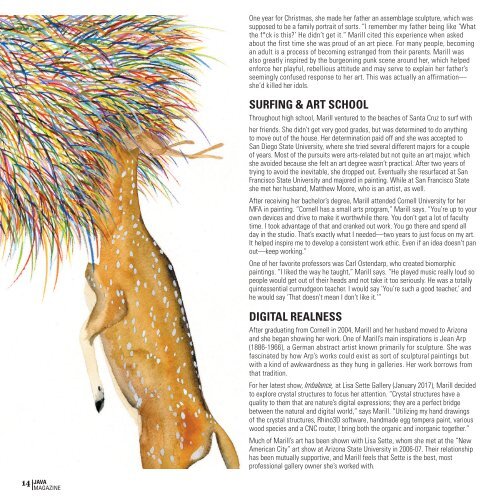Create successful ePaper yourself
Turn your PDF publications into a flip-book with our unique Google optimized e-Paper software.
One year for Christmas, she made her father an assemblage sculpture, which was<br />
supposed to be a family portrait of sorts. “I remember my father being like ‘What<br />
the f*ck is this?’ He didn’t get it.” Marill cited this experience when asked<br />
about the first time she was proud of an art piece. For many people, becoming<br />
an adult is a process of becoming estranged from their parents. Marill was<br />
also greatly inspired by the burgeoning punk scene around her, which helped<br />
enforce her playful, rebellious attitude and may serve to explain her father’s<br />
seemingly confused response to her art. This was actually an affirmation—<br />
she’d killed her idols.<br />
SURFING & ART SCHOOL<br />
Throughout high school, Marill ventured to the beaches of Santa Cruz to surf with<br />
her friends. She didn’t get very good grades, but was determined to do anything<br />
to move out of the house. Her determination paid off and she was accepted to<br />
San Diego State University, where she tried several different majors for a couple<br />
of years. Most of the pursuits were arts-related but not quite an art major, which<br />
she avoided because she felt an art degree wasn’t practical. After two years of<br />
trying to avoid the inevitable, she dropped out. Eventually she resurfaced at San<br />
Francisco State University and majored in painting. While at San Francisco State<br />
she met her husband, Matthew Moore, who is an artist, as well.<br />
After receiving her bachelor’s degree, Marill attended Cornell University for her<br />
MFA in painting. “Cornell has a small arts program,” Marill says. “You’re up to your<br />
own devices and drive to make it worthwhile there. You don’t get a lot of faculty<br />
time. I took advantage of that and cranked out work. You go there and spend all<br />
day in the studio. That’s exactly what I needed—two years to just focus on my art.<br />
It helped inspire me to develop a consistent work ethic. Even if an idea doesn’t pan<br />
out—keep working.”<br />
One of her favorite professors was Carl Ostendarp, who created biomorphic<br />
paintings. “I liked the way he taught,” Marill says. “He played music really loud so<br />
people would get out of their heads and not take it too seriously. He was a totally<br />
quintessential curmudgeon teacher. I would say ‘You’re such a good teacher,’ and<br />
he would say ‘That doesn’t mean I don’t like it.’”<br />
DIGITAL REALNESS<br />
After graduating from Cornell in 2004, Marill and her husband moved to Arizona<br />
and she began showing her work. One of Marill’s main inspirations is Jean Arp<br />
(1886-1966), a German abstract artist known primarily for sculpture. She was<br />
fascinated by how Arp’s works could exist as sort of sculptural paintings but<br />
with a kind of awkwardness as they hung in galleries. Her work borrows from<br />
that tradition.<br />
For her latest show, Imbalance, at Lisa Sette Gallery (January 2017), Marill decided<br />
to explore crystal structures to focus her attention. “Crystal structures have a<br />
quality to them that are nature’s digital expressions; they are a perfect bridge<br />
between the natural and digital world,” says Marill. “Utilizing my hand drawings<br />
of the crystal structures, Rhino3D software, handmade egg tempera paint, various<br />
wood species and a CNC router, I bring both the organic and inorganic together.”<br />
Much of Marill’s art has been shown with Lisa Sette, whom she met at the “New<br />
American City” art show at Arizona State University in 2006-07. Their relationship<br />
has been mutually supportive, and Marill feels that Sette is the best, most<br />
professional gallery owner she’s worked with.<br />
14 JAVA<br />
MAGAZINE


















